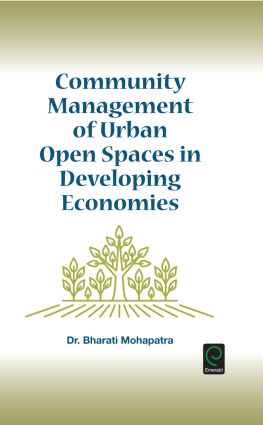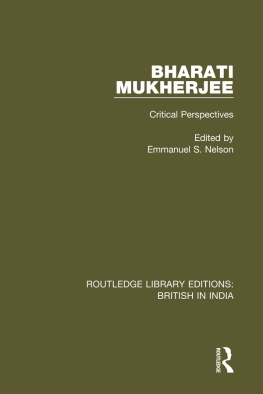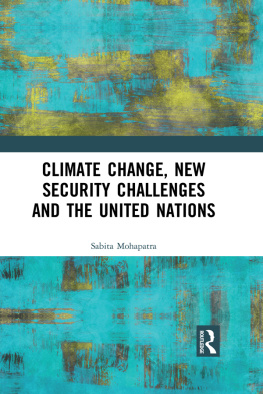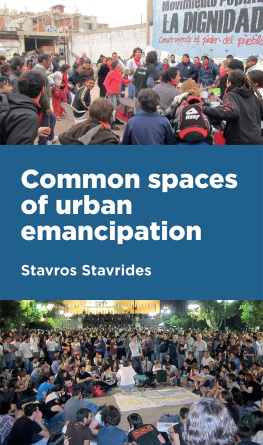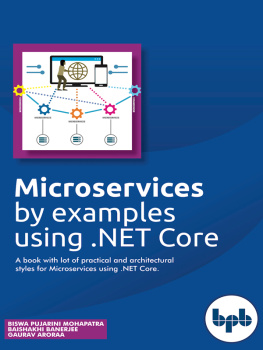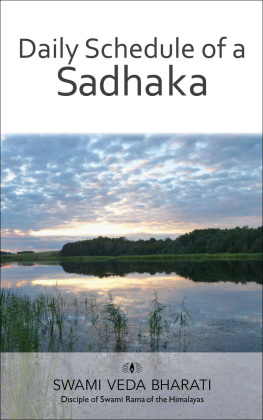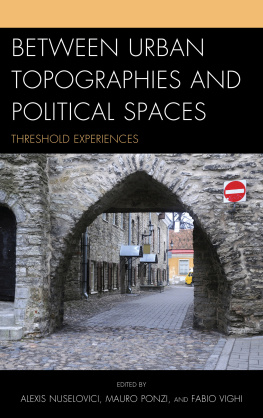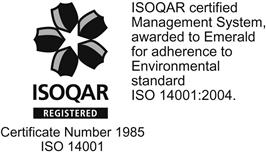Contents
Community Management of Urban Open Spaces in Developing Economies
Community Management of Urban Open Spaces in Developing Economies
By
Dr. Bharati Mohapatra
School of Planning and Architecture, Vijayawada, India

| United Kingdom North America Japan
India Malaysia China |
Emerald Group Publishing Limited
Howard House, Wagon Lane, Bingley BD16 1WA, UK
First edition 2016
Copyright 2016 Emerald Group Publishing Limited
Reprints and permissions service
Contact:
No part of this book may be reproduced, stored in a retrieval system, transmitted in any form or by any means electronic, mechanical, photocopying, recording or otherwise without either the prior written permission of the publisher or a licence permitting restricted copying issued in the UK by The Copyright Licensing Agency and in the USA by The Copyright Clearance Center. Any opinions expressed in the chapters are those of the authors. Whilst Emerald makes every effort to ensure the quality and accuracy of its content, Emerald makes no representation implied or otherwise, as to the chapters suitability and application and disclaims any warranties, express or implied, to their use.
British Library Cataloguing in Publication Data
A catalogue record for this book is available from the British Library
ISBN: 978-1-78560-639-7
Preface
H uman beings need to make contact with nature in the course of their daily lives, and no special effort or journey ought to be required for experiencing it. Neighborhood Open Spaces can provide this immediate retreat amidst built environment. With both government policy and science emphasizing the critical necessity of Open Spaces within urban social-ecological systems, a focus on people-place interactions is essential to address issues of Open Space planning and management. Neighborhood Parks are multifunctional, and create the opportunity for shared use and activity, meeting and exchange, and imbibe a sense of attachment to the place, and their design, planning and management must acknowledge these characteristics. Each of these functions and the required spatial quality should be addressed holistically to create prospects for community participation, and enhance the usability and better management of Open Space in cities.
The intimate interaction between communities and neighborhood Open Space cannot be replicated or sustained solely by government intervention, but community involvement is necessary for its effective and sustainable management. Moreover, Indian cities are reeling under development pressure, social and technological change, and insufficient resources to care for social amenities like the Open Spaces. Open Spaces in Indian cities are allocated as a land use in a broad quantitative term in city Master Plans; for example, the proposal for Open Space in the Master Plan-2015 for Bangalore city is 6.72%; Master Plan-2026 for Chennai city is 5.68%; Comprehensive Development Plan (CDP-2010) for Bhubaneswar planning area is 8.74%. The mechanism for the provision and management of public Open Space has been slowly changing during the last decade, away from complete government involvement, and toward a larger role for the community sectors.
The objective of this study is to examine the social, functional, physical, and emotional aspects of neighborhood Open Space and the attitude of people for community participation in managing the Open Space, and to develop a framework for community participation by integrating the social, psychological, and spatial attributes. Hence, the key interlinked parameters for promoting Open Space planning and management taken in the present study are: Place Use (Functional content), Place Quality (Spatial content), Place Attachment (Emotional content), Place Management (Environmental Behavior), and Levels of Participation.
These parameters are derived based on the review of literature and the context of the study. The study was carried out in the context of six neighborhood Parks in different areas of the city of Bhubaneswar. Household survey was conducted using a structured questionnaire for the interview to collect the residents response to the Place parameters.
This empirical research has adopted qualitative and quantitative methods to evaluate the status of the Open Space in the city, and the community perception and attitude toward neighborhood Open Space respectively. Statistical analysis of the Place parameters is done at two stages: Overall and neighborhood wise. At both the stages, descriptive and comparative analyses are done to evaluate the social and spatial aspects of the Open Space, and identify the linkages among the parameters.
The study brought out the conceptual findings on the usage pattern, spatial quality, and emotional attachment to the neighborhood Park, and the residents interest for participation in management, and key relationships among these parameters were identified. These conceptual outcomes are found to have a practical implication in the planning and community based management of Urban Open Space. The integrated framework is tested, based on which community management strategies can be formulated, and location-specific issues and complexities in the people-park relationship can be addressed. Consequently, effective community participation can be facilitated for sustainable management of the neighborhood Open Space.
List of Tables
List of Figures
List of Symbols and Abbreviations
Rupee |
ac | Acre |
ANOVA | Analysis of Variance |
B | Unstandarized Regression Coefficient |
BCUC | Bhubaneswar Cuttack Urban Complex |
Beta | Standardized Regression Coefficient |
BDA | Bhubaneswar Development Authority |
BDPA | Bhubaneswar Development Planning Area |
BMC | Bhubaneswar Municipal Corporation |
CBM | Community-Based Management |
CDP | Comprehensive Development Plan |
EMP | Environmental Management Plan |
EPA | Environmental Planning Agency |
F | Ratio of the Explained Variance to the Unexplained Variance |
GA | General Administration |
GFI | Goodness of Fit Index |
ha | Hectare |
HIG | Higher Income Group |
JNNURM | Jawaharlal Nehru National Urban Renewal Mission |
km | Kilometer |
m | Mean Value |
MMA | Madras Metropolitan Area |
MIG | Middle Income Group |

